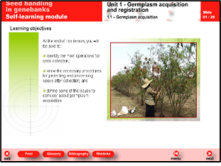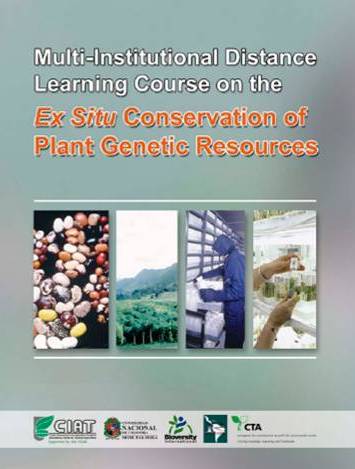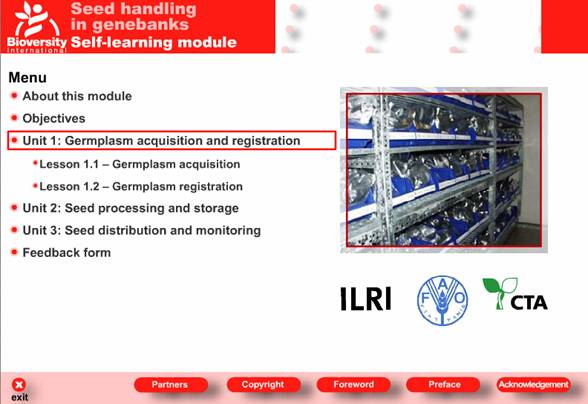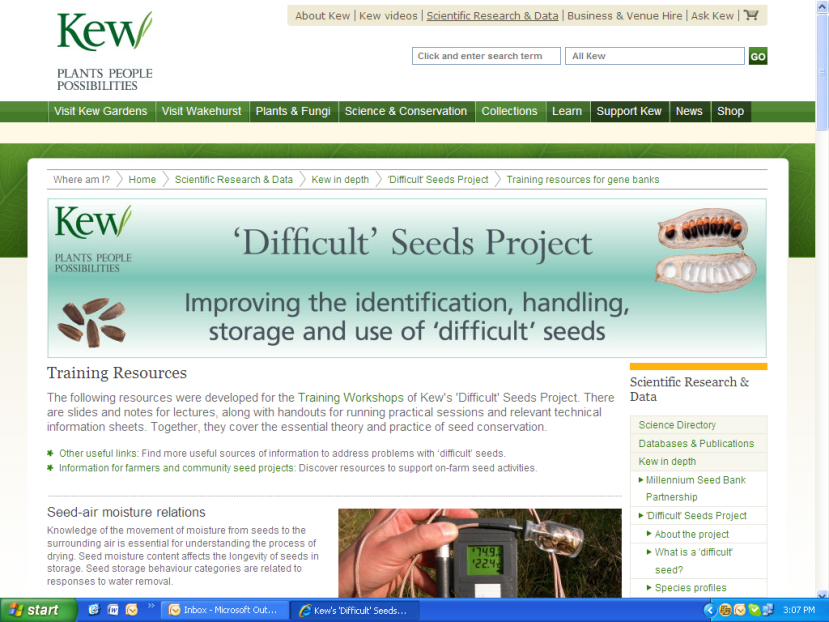CGKB News and events Learning resources
Ex situ training course
|
|
Introduction and course objectives (0.07 MB)
Module 1: Basic concepts of conservation for plant genetic resources (0.34 MB)
Module_2: Germplasm acquisition and introduction (seeds and asexual propagules) (0.2 MB)
Module_3: Germplasm conservation:
Submodule A: Multiplication and regeneration (0.07 MB)
Submodule B: Harvesting, conditioning, and quantificationsubmodule (0.23 MB)
Submodule C: Verifying the biological quality of germplasmsubmodule (0.21 MB)
Submodule D: Verifying phytosanitary quality (0.49 MB)
Submodule E: Storing germplasm (0.1 MB)
Module_4: Germplasm characterization (0.14 MB)
Module_5: Managing plant germplasm banks (0.07 MB)
Module_6: Germplasm documentation (0.08 MB)
Glossary (0.17 MB)
This course is for people working in germplasm banks, botanical gardens, arboreta, and on crop diversity projects. It is based on the materials used in the 2004 distance learning course offered to Latin American professionals and technicians with the English version adapted to serve a wider audience.
This publication covers basic concepts of:
- plant genetic resources
- germplasm acquisition
- conservation
- characterization
- documentation
- germplasm bank management
The course aims to answer why, what, for whom and how to conserve.
Training modules
 |
Please click on a topic of interest in the left hand menu.
In this section you can find training and self-learning materials on topics related to germplasm and genebank management. These materials can be used by a variety of audiences including researchers, technicians and university lecturers, among others.
The standard package of materials include:
- an introduction to the subject
- lecture support notes
- assessment questions and exercises
- further reading
- references
- notes for trainers
- slides
Many of the training moduls are available in different languages.
Seed handling in genebanks
|
Also available in: |
Seed handling in genebanks: Self learning module
(Flash plugin is required to view this course.)
This interactive self-learning module on seed handling in genebanks is drawn from the Handbook for Genebanks No. 8: Manual of Seed Handling in Genebanks (Rao et al., 2006). This is the standard reference for genebank work and one of the few sources of practical information for genebank curators and technicians on seed conservation, technology, storage and management.
The module is a stand-alone self-learning tool. It has been organized into units and lessons according to the general sequence of work undertaken in genebanks. Each lesson is presented independently, however, so that users may begin at any lesson of interest. These lessons have been derived from the manual of seed handling in genebanks below.
Click to download the Handbook for Genebanks No. 8: Manual of Seed Handling in Genebanks (Rao et al.; 2006)
English (1.5 MB) - Español (1.4 MB) - Français (1.9 MB)
Kew's "difficult" seed project: training resources for genebanks
This project supports crop gene banks and farmers in the conservation of plants used for food and agriculture in Africa, and is supported by the Food and Agriculture Organisation of the United Nations (FAO) and funded by the UK government’s Department for Environment, Food and Rural Affairs (Defra).
The training resources were developed for the project's training workshops. There are slides and notes for lectures, along with handouts for running practical sessions and relevant technical information sheets. Together, they cover the essential theory and practice of seed conservation. Useful links are provided to enable gene banks to run training courses amongst their staff, and with farmers and community seed groups.
The project webpages also contain 160 profile pages for species that have been identified as being difficult to handle, store or use. They provide details on storage behaviour, suggested storage conditions, germination requirements, and dormancy to overcome these difficulties. We have also made available our training resouces and provided.
More Articles...
- Collecting missions
- Ecogeographic Surveys
- Plant Genetic Resources and Genebank Management
- Molecular Marker Learning Modules: Volumes 1 and 2
- Law and Policy of Relevance to the Management of Plant Genetic Resources
- Transfer of Plant Genetic Resources for Food and Agriculture
- The International Treaty on Plant Genetic Resources for Food and Agriculture
- Spatial Analysis of Plant Diversity and Distribution
- Pre-breeding for Effective Use of Plant Genetic Resources: E-learning course
- CIP In vitro Genebank
Subcategories
-
Training modules
- Article Count:
- 13
-
Videos and slideshows
- Article Count:
- 25
-
Manuals and handbooks
- Article Count:
- 15
-
Powerpoint presentations
- Article Count:
- 3
-
Publications
- Article Count:
- 13
-
main
- Article Count:
- 7
-
Other languages
- Article Count:
- 6







